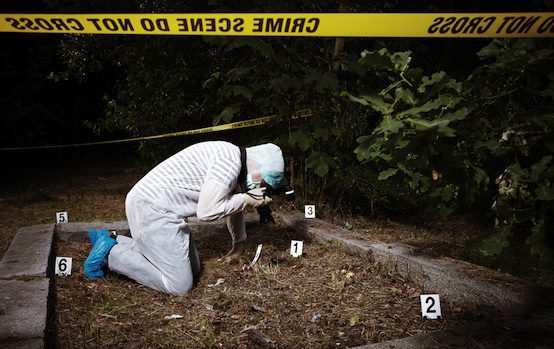When Forensic Evidence Goes Bad

Editor’s note: This is the sixth in a collaborative series with the R Street Institute exploring conservative approaches to criminal justice reform.
“(It is better) that ten guilty persons escape than that one innocent suffer.” It was the 18th-century English jurist Sir William Blackstone who first coined this theoretical basis of criminal justice, and it’s a principle with which a majority of Americans agree.
Unfortunately, far too many criminal convictions have been overturned due to false evidence, including what is often considered to be gospel—forensic evidence.
Forensic science is a fundamental tool of the criminal justice system. However, a growing number of scandals have illustrated that not everyone in this field is qualified or immune to systemic bias. And as research continues to develop, some forms of forensic science have been proven to be, well, unreliable.
Science as a law enforcement tool has become wildly popular over the last two decades—from its pervasiveness in higher education criminal justice programs to its persistent presence in media culture (see: NCIS and its spinoffs). But its credibility has nonetheless been an issue for many years. For example, former FBI agent Frederic Whitehurst, who began working in the bureau’s crime lab in 1994, immediately noticed that many of the staffers were not qualified to conduct scientific analysis. He subsequently became a whistleblower and exposed that many FBI staffers had falsely testified about the level of their expertise and reliability of their evidence.
Whitehurst’s dogged quest for upholding the integrity of the system led to his ouster in 1998. His efforts resulted in some internal reforms, but many of the systemic problems appear unresolved more than 20 years later.
Meanwhile, in 2015, the Department of Justice, the FBI, the Innocence Project, and the National Association of Criminal Defense Lawyers (NACDL) released an alarming report that found a 90 percent error rate in 500 FBI cases that the team reviewed. Remarkably, 26 out of 28 FBI hair analysis “experts” provided erroneous statements. Worst of all, several people were executed as a result of this evidence. Of the 35 cases that ended in a death penalty sentencing, 33 included erroneous statements from FBI staff.
TV and movies have promoted another type of forensic science—bite mark analysis–whose validity numerous studies have nullified. Among them is one by the Obama administration’s Presidential Council of Advisors on Science and Technology in 2016.
Popular culture also loves to promote bloodstain pattern analysis as being foolproof, but it’s anything but. Even experts with years of training at times disagree on the conclusions from this evidence. In May of this year, ProPublica and The New York Times Magazine extensively reviewed Joe Bryan’s 1986 murder conviction. A jury had found that Bryan murdered his wife, in large part due to testimony by a police investigator with a 40-hour training certificate in bloodstain-pattern analysis.
Bryan was convicted despite there being an alibi, character witnesses, and physical evidence that suggested his innocence. In the aftermath, several experts with far more experience rebutted the bloodstain-pattern testimony and concluded that there should have been a retrial.
With that said, this case isn’t a one-off. There are many police investigators who testify as bloodstain-pattern experts despite possessing only cursory training certificates.
This is one of several examples of how faulty forensics have forced innocent people into prison. To be exact, false or misleading forensic science is responsible for 24 percent of the 2,258 exonerations that have occurred in this country since 1989, according to the National Registry of Exonerations.
As a proactive measure, the Obama administration formed the National Commission on Forensic Science in 2013 to improve standards. However, Trump Attorney General Jeff Sessions decided last year to discontinue the commission.
Likewise, several scandals have exposed the poor standards and lack of independence in many crime labs where evidence is handled. Annie Dookhan, a chemist with the Massachusetts state drug lab, was found to have falsified evidence in over 21,000 cases. She was highly regarded by her supervisors because she processed over three times as many cases as other analysts. Her secret to success was simply not doing all of the necessary tests, or any at all.
This scandal, like many others, demonstrated the institutional bias within many crime labs. Moreover, emails show that the conflict of interest went well beyond the implicit in Dookhan’s case. She was in close contact with prosecutors and viewed herself as part of the team. Whereas with defense attorneys, she was hesitant to even respond.
This was not an isolated incident. Scandals in other cities vary by degrees of incompetence and deceit but the general theme more or less involves unqualified staff and/or biased analysts.
An audit from two years ago of the crime lab in Austin, Texas, found that one tech with nearly 5,000 drug cases under his belt had “a lack of understanding of chemistry” and a 33 percent error rate. Regardless, he received a promotion due to limited staffing.
One year earlier, it was revealed that the San Francisco crime lab had a criminologist who withheld DNA evidence linked to the likely killer in a 2010 double homicide case. That’s just one of multiple issues at that lab—two criminologists there failed national proficiency tests and a technician stole large amounts of cocaine back in 2010.
We need to heed the words of Sir William Blackstone because the evils of punishing the innocent are far worse than letting the guilty go free. Right now we seem to have a system that assumes the opposite—and unfortunately forensic evidence, regarded as unimpeachable by so many, is part of the problem.
Brian Saady is the author of the series Rackets, which chronicles the legalization of drugs and gambling, and the decriminalization of prostitution. You can check out his podcast and follow him on Facebook and Twitter.
Comments